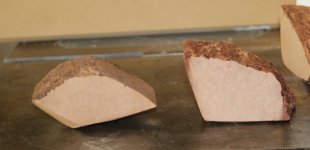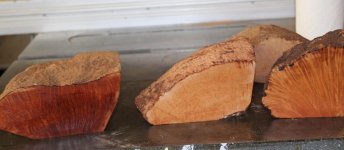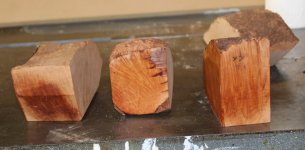I haven't spent much time thinking about the origin of the briar. My vote would be to ask Jose Rubio, Jack Howell, Read Davis, Ryan Alden and Martin Cermak what briar they use. I have quite a few pipes from those gentlemen and they all smoke fantastic. So they must use superior briar or perhaps, the carver has a lot more to do with the end product than the briar itself.
Is old Algerian Briar Superior?
- Thread starter Briar Lee
- Start date
You are using an out of date browser. It may not display this or other websites correctly.
You should upgrade or use an alternative browser.
You should upgrade or use an alternative browser.
SmokingPipes.com Updates
Watch for Updates Twice a Week
It's the least important part of the equation as far as I can tell. If a maker cuts a piece of briar and it smells like a gangrenous foot, I think most of us would stop and throw it out. Usually briar smells a little bready, sometimes a little spice. I currently have briar in my shop from 2 mills in Spain, 2 in Italy, and 2 in Greece, and some Algerian. It is slightly different country to country and mill to mill.
I recently sent a pipe made from Spanish wood to another pipe maker, and he felt like it tasted different than the Italian wood he was using. Not better or worse, just.... slightly different.
Usually pipe makers get a relationship going with a cutter who offers cuts or sizes or grading or pricing or whatever it is that suits the pipe maker. For myself, as an example, getting a phytosanitary certificate proper is really helpful for importing briar. So I buy from people who can get that for me for my regular stock.
But in all the conversations I've had with pipemakers over the last 10 years, hundreds of conversations with 50 different people... not one of them has ever said "I sure like how such-and-such briar sandlbasts, but I wish it smoked better." It all works more or less the same when you light it up. As it should - it's all the same species of plant, and it's all treated more or less the same way. Cut, boiled, dried, sold.
I recently sent a pipe made from Spanish wood to another pipe maker, and he felt like it tasted different than the Italian wood he was using. Not better or worse, just.... slightly different.
Usually pipe makers get a relationship going with a cutter who offers cuts or sizes or grading or pricing or whatever it is that suits the pipe maker. For myself, as an example, getting a phytosanitary certificate proper is really helpful for importing briar. So I buy from people who can get that for me for my regular stock.
But in all the conversations I've had with pipemakers over the last 10 years, hundreds of conversations with 50 different people... not one of them has ever said "I sure like how such-and-such briar sandlbasts, but I wish it smoked better." It all works more or less the same when you light it up. As it should - it's all the same species of plant, and it's all treated more or less the same way. Cut, boiled, dried, sold.
Every carver uses as a matter of course, Mediterranean briar and unless for novelty’s sake, never Mission Briar from California.I haven't spent much time thinking about the origin of the briar. My vote would be to ask Jose Rubio, Jack Howell, Read Davis, Ryan Alden and Martin Cermak what briar they use. I have quite a few pipes from those gentlemen and they all smoke fantastic. So they must use superior briar or perhaps, the carver has a lot more to do with the end product than the briar itself.
The heath trees look like shrubs to me.
View attachment 101779
It's the least important part of the equation as far as I can tell. If a maker cuts a piece of briar and it smells like a gangrenous foot, I think most of us would stop and throw it out. Usually briar smells a little bready, sometimes a little spice. I currently have briar in my shop from 2 mills in Spain, 2 in Italy, and 2 in Greece, and some Algerian. It is slightly different country to country and mill to mill.
I recently sent a pipe made from Spanish wood to another pipe maker, and he felt like it tasted different than the Italian wood he was using. Not better or worse, just.... slightly different.
Usually pipe makers get a relationship going with a cutter who offers cuts or sizes or grading or pricing or whatever it is that suits the pipe maker. For myself, as an example, getting a phytosanitary certificate proper is really helpful for importing briar. So I buy from people who can get that for me for my regular stock.
But in all the conversations I've had with pipemakers over the last 10 years, hundreds of conversations with 50 different people... not one of them has ever said "I sure like how such-and-such briar sandlbasts, but I wish it smoked better." It all works more or less the same when you light it up. As it should - it's all the same species of plant, and it's all treated more or less the same way. Cut, boiled, dried, sold.
From what I’ve read, before the Algerian War in the 1960’s the northern African nation of Algeria had a briar export industry. The sources say the French firebombed the briar growing regions.
I don’t question that the French did, but I’ve been trying to burn cedar trees for all my life abd there’s still plenty of surviving cedar trees. I’d say it was more likely the war ended the safe harvesting and sale of briar roots.
About the only other nationalities of briar I’ve seen pipe makers brag they used is Grecian and Corsican.
I happen to live in the only region on earth where white oak staves for bourbon whiskey barrels are harvested.
There are 22 different oak tree species in Missouri, plus at least 30 hybrid crosses of those, and 8 are considered part of the white oak family.

Oaks
There are 22 species of oaks that grow native or are naturalized in Missouri. Also, more than 30 different oak hybrids (crosses between the various species) have been recorded in the state. The oaks, which are related to beech, chestnut, and chinquapin, have several distinguishing...
Many years ago our family allowed a logger to select white oak logs for sale to the Independent Stave Company in Lebanon. I rode with him to Lebanon.
There was an inspector there, which only accepted one particular white oak log, of a certain size, and loggers had to register themselves plus their log truck VIN numbers.
The inspector accepted our load, and the price then averaged $200 a log, or about five or ten times what those logs would have fetched at a sawmill.
But if the inspector had rejected any log, at least then of you tried passing off an oak that was not a white oak stave bolt type, then not only your entire load but you and your truck were blackballed from ever again selling stave bolt white oaks ever again. They didn’t want another hillbilly driving the same truck back, for another try.
Years ago when there was a substantial briar industry in Algeria, I wonder how the pipe making industry kept them honest?
This thing of ours, this pipe thing, makes me wonder as well. It is no longer a large industry, but st I’llll it persists. I wonder things about the profit margins and the ability to maintain the critical infrastructure necessary to make pipes.
My theory is that he gave up making pipes and went into the jeans business…So all of these stories and enigmas, and we dont even know who Lee is?!?!?
A mystery.....
Who would have thunk - oil-cured denim. Explains their durability and why they don't take breaking-in ?My theory is that he gave up making pipes and went into the jeans business…
Another thing about briar, is that today even the lowest grade of factory smoker is a Dr Grabow, and every new Dr. Grabow and Royalton I’ve bought the last forty years has been a well made, well finished little piece of jewelry that you can smoke.
There’s no demand for el cheapo Brylon tongue burners today, or phenolic The Pipe plastic pipes like I bought at the UMKC student union in the seventies.
A Royalton costs $80.
$80 Royalton photo from Amazon
View attachment 101805
But for $170 you can buy a gorgeous Briar Works Devil Anse.
View attachment 101806
The extreme bottom end of the pipe market is gone.
When perhaps a hundred times more pipes a year were sold than today, a natural colored straight grained smooth Algerian briar pipe was a rare luxury item.
It helps those pipe makers to all emulate our old friend Lee, and sell the sizzle instead of the steak.
Lee said Reach for the Stars.
Symbol of the World’s Finest Pipes.
He may have used Algerian briar, but he never talked about it at all.
$25 grade Five Star Lee
View attachment 101807
There’s no demand for el cheapo Brylon tongue burners today, or phenolic The Pipe plastic pipes like I bought at the UMKC student union in the seventies.
A Royalton costs $80.
$80 Royalton photo from Amazon
View attachment 101805
But for $170 you can buy a gorgeous Briar Works Devil Anse.
View attachment 101806
The extreme bottom end of the pipe market is gone.
When perhaps a hundred times more pipes a year were sold than today, a natural colored straight grained smooth Algerian briar pipe was a rare luxury item.
It helps those pipe makers to all emulate our old friend Lee, and sell the sizzle instead of the steak.
Lee said Reach for the Stars.
Symbol of the World’s Finest Pipes.
He may have used Algerian briar, but he never talked about it at all.
$25 grade Five Star Lee
View attachment 101807
Last edited:
You bring up a great point about Grabows being "low grade". Wether that's true or not, my Grabow pipes always smoke just as well as any pipe I've ever had. The fact that they are pre smoked at the factory, suggests that there's no break in time. And I've found that to be true. Just stuff it and puff it. And they can certainly handle a lot of stress and keep on going.Another thing about briar, is that today even the lowest grade of factory smoker is a Dr Grabow, and every new Dr. Grabow and Royalton I’ve bought the last forty years has been a well made, well finished little piece of jewelry that you can smoke.
There’s no demand for el cheapo Brylon tongue burners today, or phenolic The Pipe plastic pipes like I bought at the UMKC student union in the seventies.
A Royalton costs $80.
$80 Royalton photo from Amazon
View attachment 101805
But for $170 you can buy a gorgeous Briar Works Devil Anse.
View attachment 101806
The extreme bottom end of the pipe market is gone.
When perhaps a hundred times more pipes a year were sold than today, a natural colored straight grained smooth Algerian briar pipe was a rare luxury item.
It helps those pipe makers to all emulate our old friend Lee, and sell the sizzle instead of the steak.
Lee said Reach for the Stars.
Symbol of the World’s Finest Pipes.
He may have used Algerian briar, but he never talked about it at all.
$25 grade Five Star Lee
View attachment 101807
Maybe the reason we see “superior Algerian briar” stamped on pipes is because all the guy had was a pile of the crappiest Algerian briar, so he picked out some chunks that would “make do” and made some pipes. Thus, of all the crappiest algerian briar, these pipes were the made from the best of the crappiest, the superior Algerian. It’s just a guess. But, if all Algerian was superior, wouldn’t they just say “Algerian Briar”? And, the term “Algerian” would signify quality? Just a guess. 
we don’t see “superior Cuban” cigars, or “superior French wines” or “Superior Italian handmade shoes” or “superior” anything, unless there’s some doubt involved. Just a guess.

we don’t see “superior Cuban” cigars, or “superior French wines” or “Superior Italian handmade shoes” or “superior” anything, unless there’s some doubt involved. Just a guess.
Every carver uses as a matter of course, Mediterranean briar and unless for novelty’s sake, never Mission Briar from California.
The heath trees look like shrubs to me.
View attachment 101779
From what I’ve read, before the Algerian War in the 1960’s the northern African nation of Algeria had a briar export industry. The sources say the French firebombed the briar growing regions.
I don’t question that the French did, but I’ve been trying to burn cedar trees for all my life abd there’s still plenty of surviving cedar trees. I’d say it was more likely the war ended the safe harvesting and sale of briar roots.
About the only other nationalities of briar I’ve seen pipe makers brag they used is Grecian and Corsican.
I happen to live in the only region on earth where white oak staves for bourbon whiskey barrels are harvested.
There are 22 different oak tree species in Missouri, plus at least 30 hybrid crosses of those, and 8 are considered part of the white oak family.

Oaks
There are 22 species of oaks that grow native or are naturalized in Missouri. Also, more than 30 different oak hybrids (crosses between the various species) have been recorded in the state. The oaks, which are related to beech, chestnut, and chinquapin, have several distinguishing...mdc.mo.gov
Many years ago our family allowed a logger to select white oak logs for sale to the Independent Stave Company in Lebanon. I rode with him to Lebanon.
There was an inspector there, which only accepted one particular white oak log, of a certain size, and loggers had to register themselves plus their log truck VIN numbers.
The inspector accepted our load, and the price then averaged $200 a log, or about five or ten times what those logs would have fetched at a sawmill.
But if the inspector had rejected any log, at least then of you tried passing off an oak that was not a white oak stave bolt type, then not only your entire load but you and your truck were blackballed from ever again selling stave bolt white oaks ever again. They didn’t want another hillbilly driving the same truck back, for another try.
Years ago when there was a substantial briar industry in Algeria, I wonder how the pipe making industry kept them honest?
Let me get this straight; you think Lee was using stealing stave-grade white oak for his pipes?
B. Lee: What does Algerian briar "look like"? Or perhaps our pipe makers can tell me.
And "needs no breaking in"- for you- but for me a new pipe needs at least the carbonization of the chamber. Obviously, mileage varies.
And "needs no breaking in"- for you- but for me a new pipe needs at least the carbonization of the chamber. Obviously, mileage varies.
The pipe "space race" was fun and silly, a really great example of marketing being a dominant and undying (unkillable) force in retail.
This is real briar, not the fake briar. "Bruyere Garantie"
Oh yeah? Well THIS is not just briar but ALGERIAN briar.
Oh YEAH? Well our pipe has an aluminum gizmo that prevents tongue bite.
OH YEAH?? .... well our pipe has a better gizmo, Algerian ultra select wonder briar that dates to the late Cretaceous, and the pipe lights itself. Beat that!
And we poor saps lick it up, we love it.
For the sake of a shit and a giggle, I'll take a few pictures of some algerian briar.
I think I could tell Algerian briar when working with it. I don't think I could tell after a pipe is made, not from just looking at it.
This is real briar, not the fake briar. "Bruyere Garantie"
Oh yeah? Well THIS is not just briar but ALGERIAN briar.
Oh YEAH? Well our pipe has an aluminum gizmo that prevents tongue bite.
OH YEAH?? .... well our pipe has a better gizmo, Algerian ultra select wonder briar that dates to the late Cretaceous, and the pipe lights itself. Beat that!
And we poor saps lick it up, we love it.
For the sake of a shit and a giggle, I'll take a few pictures of some algerian briar.
I think I could tell Algerian briar when working with it. I don't think I could tell after a pipe is made, not from just looking at it.
As long at it's marked Ne plus ultra! Or Very very Superior Briar.
Briar Lee said
That reminds me of an old hillbilly song, but most things do.
AFTER THE FIRE IS GONE
Country music is not your forte because that isn't a hillbilly song.

Here's a couple briar blocks. I mean... it's briar. On the left, typical modern Algerian, a small root, fine grain. Not much room for a big pipe in there.

If I splooch a little wax onto 3 blocks, we see very different results - Algerian, Greek, and Spanish here.
The Algerian is typically a real bricky color, you don't get to do a high-contrast finish with this stuff because it's pretty dark.
The Greek is showing less "straight grain" because it's actually a pretty crooked cut:

Of these 3, the Spanish on the right is the most promising. It's cut really well, super clean wood, very even grain. The Algerian is showing a weird growth line or flaw about a 1/2" from the top (dark line in the side profile shot). But these are all good quality briar blocks, much better than you'd see dumped out in most factory environments. And stained up, it would be hard to tell where any of these roots came from.
It's good to go back and actually watch historical pipe making: Briar delivered by the hundred dozen, and cranked out as fast as possible.
Let me get this straight; you think Lee was using stealing stave-grade white oak for his pipes?
I just found the most interesting page from the Christmas 1945 Wally Frank catalog. I have a sneaking suspicion that Lee was actually Wally Frank, by the way.
The war is over, it’s the first Christmas of peace. Most of the boys are still overseas.
And our friend Wally Frank is peddling Christmas presents. His highest priced pipes in a catalog brimming with dollar and two dollar pipes, were the “Dings”.
Frank said defense workers turned the briar at home, they are bench made, and finally when stem materials were available and the defense work was done, he released the Brobdingnag!ans!
Wikipedia
The Brobdingnagians are a morally righteous race, detesting the war, greed, and corruption for which author Jonathan Swift saw the British Monarchy of the time to stand. Physically enormous with a description of 60 feet tall, their moral stature is also huge. Brobdingnag, as a society, is a practical and moral utopia, and among the Brobdingnagians, there is all the peace, goodwill and calm virtue of a true fantasy world. Their laws encourage charity and grace, though underneath it all they are just a people who labor under every disadvantage know to all "men." In the novel, they are described as being ugly when magnified through Gulliver's point of view, but they are characteristically beautiful in their thoughts and actions. They are the epitome of the "beauty is only skin deep" and "don't judge a book by its cover" clichés.
—-
View attachment 101841
Last edited:
Great illustrations, Sasquatch and Briar Lee. Thank you!
View attachment 101837
Here's a couple briar blocks. I mean... it's briar. On the left, typical modern Algerian, a small root, fine grain. Not much room for a big pipe in there.
View attachment 101838
If I splooch a little wax onto 3 blocks, we see very different results - Algerian, Greek, and Spanish here.
The Algerian is typically a real bricky color, you don't get to do a high-contrast finish with this stuff because it's pretty dark.
The Greek is showing less "straight grain" because it's actually a pretty crooked cut:
View attachment 101839
Of these 3, the Spanish on the right is the most promising. It's cut really well, super clean wood, very even grain. The Algerian is showing a weird growth line or flaw about a 1/2" from the top (dark line in the side profile shot). But these are all good quality briar blocks, much better than you'd see dumped out in most factory environments. And stained up, it would be hard to tell where any of these roots came from.
It's good to go back and actually watch historical pipe making: Briar delivered by the hundred dozen, and cranked out as fast as possible.
Although my father didn’t have but two years at Humansville High school after graduating from Eighth Grade at Rosebud School (a one room school his grandfather help organize, with the nearest post office being the tiny town of Sexton, which changed it’s name to Hamlet (after the then owner) and finally to the actual town the fictional Jed Clampett hailed from, Bug Tussle) my father was a handsome, well mannered, man who accomplished two extraordinary things in his life:
1. He won and married the most beautiful of two daughters of famous local author Myrtle Cahow “Ma” Agee, who wrote for The Index at Hermitage, Missouri. Because of this, Ma Agee married off her “purdy daw-ter Saydee who had jay bird heels to a boy who lived way over in Polk County near Bug Tussle”. This insured my father a measure of reflected glory, as Saydee’s husband.
2. I still have the plans for the scientifically designed elevated stanchion four cow Grade A milk barn my father worked with the University of Missouri to build, and I still own the milk barn. Between folks coming to see Saydee, who really did live south of Bug Tussle (Ella Mae Clampett, played by Donna Douglas, was a cheap dime store blond compared to my Mama) my father’s model milk barn drew university professors and agriculturists and occasionally cultural anthropologists who were aware there really was such a town as Bug Tussle, which joins our home place on the north side.
I learned out in the milk barn, listening to visitors, that in this world are experts on everything from why I talk like I do, to which brand of filter that strains milk the best, to which cow gives the best tasting milk.
My Daddy kept 25 cows, more or less, milking all the time. Usually he kept one Jersey cow, the remainder Holsteins.
He’d milk a pair of cows every eight minutes and spend two minutes changing milkers and letting out Holsteins.
For eight out of ten minutes he’d visit with the folks that came to watch the show. My mother, and often Ma Agee herself, would come and serve sweet tea, coffee, and pastries to visitors, then visit with their wives.
If a visitor wanted to sample the milk, which I understood was of questionable legality since it was unpasteurized, Daddy always had them come in when he milked that odd numbered hind cow, the Jersey that gave the sweetest and best tasting milk. He’d milk the cow, and my mother would put the container on ice, then shake it up again and serve the milk.
The tasters would always agree, that milk beat all they’d even dreamed of tasting.
Was it the Jersey, or the show that produced the milk?
If Algerian briar wasn’t best, it’s promoters tried to make it best.
YOU BEAT ALL I’VE EVER SEEN
Well, I've learned there is a town in Missouri named after me.Although my father didn’t have but two years at Humansville High school after graduating from Eighth Grade at Rosebud School (a one room school his grandfather help organize, with the nearest post office being the tiny town of Sexton, which changed it’s name to Hamlet (after the then owner) and finally to the actual town the fictional Jed Clampett hailed from, Bug Tussle) my father was a handsome, well mannered, man who accomplished two extraordinary things in his life:
1. He won and married the most beautiful of two daughters of famous local author Myrtle Cahow “Ma” Agee, who wrote for The Index at Hermitage, Missouri. Because of this, Ma Agee married off her “purdy daw-ter Saydee who had jay bird heels to a boy who lived way over in Polk County near Bug Tussle”. This insured my father a measure of reflected glory, as Saydee’s husband.
2. I still have the plans for the scientifically designed elevated stanchion four cow Grade A milk barn my father worked with the University of Missouri to build, and I still own the milk barn. Between folks coming to see Saydee, who really did live south of Bug Tussle (Ella Mae Clampett, played by Donna Douglas, was a cheap dime store blond compared to my Mama) my father’s model milk barn drew university professors and agriculturists and occasionally cultural anthropologists who were aware there really was such a town as Bug Tussle, which joins our home place on the north side.
I learned out in the milk barn, listening to visitors, that in this world are experts on everything from why I talk like I do, to which brand of filter that strains milk the best, to which cow gives the best tasting milk.
My Daddy kept 25 cows, more or less, milking all the time. Usually he kept one Jersey cow, the remainder Holsteins.
He’d milk a pair of cows every eight minutes and spend two minutes changing milkers and letting out Holsteins.
For eight out of ten minutes he’d visit with the folks that came to watch the show. My mother, and often Ma Agee herself, would come and serve sweet tea, coffee, and pastries to visitors, then visit with their wives.
If a visitor wanted to sample the milk, which I understood was of questionable legality since it was unpasteurized, Daddy always had them come in when he milked that odd numbered hind cow, the Jersey that gave the sweetest and best tasting milk. He’d milk the cow, and my mother would put the container on ice, then shake it up again and serve the milk.
The tasters would always agree, that milk beat all they’d even dreamed of tasting.
Was it the Jersey, or the show that produced the milk?
If Algerian briar wasn’t best, it’s promoters tried to make it best.
YOU BEAT ALL I’VE EVER SEEN
Sooooo… you are putting forth the idea (and spent a lot of words doing so) that there is such a thing as an inarguably objective superiority to that cow’s milk over those of the other cow’s, which goes to show that Algerian briar is superior to briar from other places, and not just other Algerian briars?
Okie dokey, the irony is that my grandma tells a tale of driving through Missouri, and stopped at a cowfarm run by a man with only an 8th grade education. She said that he was soooo prpid and excited about some bucket of milk he had, that he pressured her into trying some, and she felt so badly for the guy, that she sang praises upon his milk, even though she didn’t really care for sweet milk. But, being a stranger to those lands and their strange ways, she felt obliged to say nice things and be on her merry way. She oater stopped at a store where others had gathered to discuss that man’s milk and hos odd ways of pushing it off on people as they pass.
So this is the reason oil curing briar doesn’t impact the estate market as much as one might think.
Now, I’m just pulling your chain a bit. I’m certainly not going to lose sleep over Algerian Briar. I have a few with that stamp, and they smoke fine. I wouldn’t rave about them. I have pipes I like better. But, they aren’t dogs, for sure.
Okie dokey, the irony is that my grandma tells a tale of driving through Missouri, and stopped at a cowfarm run by a man with only an 8th grade education. She said that he was soooo prpid and excited about some bucket of milk he had, that he pressured her into trying some, and she felt so badly for the guy, that she sang praises upon his milk, even though she didn’t really care for sweet milk. But, being a stranger to those lands and their strange ways, she felt obliged to say nice things and be on her merry way. She oater stopped at a store where others had gathered to discuss that man’s milk and hos odd ways of pushing it off on people as they pass.
So this is the reason oil curing briar doesn’t impact the estate market as much as one might think.

Now, I’m just pulling your chain a bit. I’m certainly not going to lose sleep over Algerian Briar. I have a few with that stamp, and they smoke fine. I wouldn’t rave about them. I have pipes I like better. But, they aren’t dogs, for sure.






